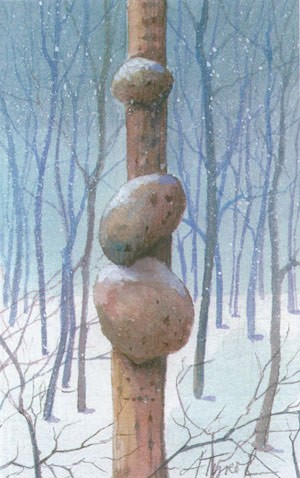
During the most recent ice age, the Great Plains were part of a white spruce forest that existed in a broad, transcontinental band south of the tundra, which in turn extended north to the southern limit of the glaciers. White spruce still grows farther north on this continent than any other conifer, and now almost all of its range is in Canada and Alaska, where it is an important part of the vast boreal forest, stretching from Newfoundland to Alaska. In the Northeast, it grows only in the northern parts of New York, Vermont, and New Hampshire, but most of Maine has white spruce. White spruce seems to like cold ocean fog, and the dense white spruce stands that edge Maine’s rocky coast and offshore islands add enormously to the beauty of that landscape.
White spruce is often a beautiful tree, with a full, dense crown of blue-green needles and graceful lower branches that ascend at the tips. Red-brown cones decorate the upper parts of the tree when there is a good seed crop; usually this occurs at 2- to 6-year intervals. Although it is one of the most accommodating conifers and can tolerate wind, drought, cold, heat, and overcrowding, a white spruce on a good site is still a far larger and lovelier specimen than one growing under substandard conditions.
Interestingly, trees in the least favorable environments grow to be far older than thriving specimens: above the Arctic Circle, some spruces are more than 1,000 years old, compared to the 250-year-or-so maximum lifespan of a tree in a more moderate environment. On good sites, white spruces are over three feet in diameter and sometimes more than 180 feet tall. At the other extreme, they are reduced to krummholz and when the climate is exceedingly harsh, they do not produce cones. Instead they form new trees when the lower branches are pressed to the ground, take root, and send up a new trunk – a process called layering.
Natural white spruce stands can be either even-aged or uneven-aged. Following stand-destroying fires, which are common in the boreal forest, aspen, birch, and poplar quickly become established, but these species later give way to a new stand of white spruce.
The progressive abandonment of agricultural land in the Northeast over the past 100 or more years may have caused an increase in the amount of white spruce in our region. Sometimes it becomes dominant on former fields, and, as the tree crowns close, feathermosses, liverworts, and small boreal plants such as starflower and goldthread take over at ground level. The Usnea lichen, commonly called old man’s beard, may be abundant enough to allow you to imagine that you are at the edge of the tundra.
This tree’s beauty is often ruined by large, roundish, tumor-like growths on the trunk and branches; occasionally they are two to three feet in diameter, and woodworkers seek them out for turning into bowls. Sometimes trees are loaded with these deformities, but their cause is unknown. For many galls, a virus, insect, or other agent is know to be the initiator, but so far the culprit of white spruce gall has not been found. It does serve one utilitarian purpose: if you see this stem gall on a tree, you have identified a white spruce. Another diagnostic feature is the odor of the crushed foliage, which most people find smells like skunk or, even worse, cat urine.
The almost-white wood is lightweight, strong, and straight-grained, and it is similar enough to red spruce wood that the two species are simply sold together as “spruce.” It can be grown into good-quality logs, but the majority of white spruce ends up as pulpwood. By the time a typical tree is 70 or so years old, the probability that rot has gotten a foothold is on the rise.
A large number of wild animals go to white spruce for food, with the red squirrel and spruce grouse at the front of the line. Red squirrels can live all winter eating nothing but the nutritious seeds of white spruce, and this tree is so important to them that the squirrel population may rise and fall with the seed crop. When seeds are scarce, red squirrels nip off and eat branch tips in the winter. Squirrels also feed on buds in the spring.
All winter, spruce grouse eat spruce needles. Snowshoe hare eat the needles, bark, and twigs, and mice and voles the seedlings. Chipmunks, chickadees, nuthatches, crossbills, and pine siskins eat the seeds. Deer have little interest in any part of white spruce, unless it’s protecting them from deep snow in a deeryard.

